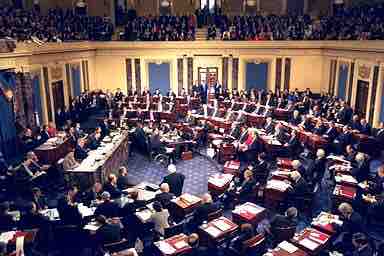Background
Article I of the Constitution states all legislative powers herein granted shall be vested in a Congress of the United States, which shall consist of a Senate and a House of Representatives. The House and Senate are equal partners in the legislative process—legislation cannot be enacted without the consent of both chambers. However, the Constitution grants each chamber some unique powers. The Senate ratifies treaties and approves presidential appointments while the House initiates revenue-raising bills. The House initiates impeachment cases, while the Senate decides impeachment cases. A two-thirds vote of the Senate is required before an impeached person can be forcibly removed from office.
Congress has implied powers deriving from the Constitution's Necessary and Proper Clause which permit Congress to "make all laws which shall be necessary and proper for carrying into execution the foregoing powers, and all other powers vested by this Constitution in the government of the United States, or in any department or officer thereof. " Broad interpretations of this clause and of the Commerce Clause, the enumerated power to regulate commerce, in rulings such as McCulloch v Maryland have effectively widened the scope of Congress's legislative authority far beyond that prescribed in Section 8.
Congress Overseeing the Executive Branch
One of Congress's foremost non-legislative functions is the power to investigate and oversee the executive branch. Congressional oversight is usually delegated to committees and is facilitated by Congress's subpoena power. Some critics have charged that Congress has, in some instances, failed to do an adequate job of overseeing the other branches of government. In the Plame affair, critics, including Representative Henry A. Waxman, charged that Congress was not doing an adequate job of oversight in this case. There have been concerns about congressional oversight of executive actions such as warrantless wiretapping, although others respond that Congress did investigate the legality of presidential decisions.
Congress also has the exclusive power of removal, allowing impeachment and removal of the president, federal judges and other federal officers. There have been charges that presidents acting under the doctrine of the unitary executive have assumed important legislative and budgetary powers that should belong to Congress. So-called 'signing statements' are one way in which a president can "tip the balance of power between Congress and the White House a little more in favor of the executive branch," according to one account. Past presidents, including Ronald Reagan, George H. W. Bush, Bill Clinton, and George W. Bush have made public statements when signing congressional legislation about how they understand a bill or plan to execute it, and commentators including the American Bar Association have described this practice as against the spirit of the Constitution. There have been concerns that presidential authority to cope with financial crises is eclipsing the power of Congress

The impeachment trial of President Clinton
Floor proceedings of the U.S. Senate, in session during the impeachment trial of Bill Clinton.
Power in Committees
Committees write legislation. While procedures such as the House discharge petition process can introduce bills to the House floor and effectively bypass committee input, they are exceedingly difficult to implement without committee action. Committees have power and have been called 'independent fiefdoms'. Legislative, oversight, and internal administrative tasks are divided among about two hundred committees and subcommittees which gather information, evaluate alternatives, and identify problems. They propose solutions for consideration by the full chamber. They also perform the function of oversight by monitoring the executive branch and investigating wrongdoing.
Bills and resolutions
In order to form a bill or resolution, first the House Financial Services committee meets. Committee members sit in the tiers of raised chairs, while those testifying and audience members sit below. Ideas for legislation can come from members, lobbyists, state legislatures, constituents, legislative counsel, or executive agencies. Usually, the next step is for the proposal to be passed to a committee for review. A submitted proposal usually takes one of the following forms:
- A bill, which is a law in the making.
- A joint resolution, which differs little from a bill since both are treated similarly. However, a joint resolution originates from the House.
- A Concurrent Resolutions, which affects both House and Senate and thus are not presented to the president for approval later.
- Simple resolutions, which concern only the House or only the Senate.